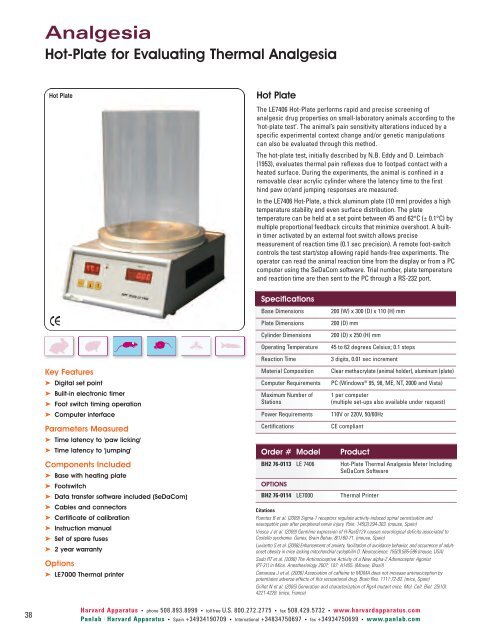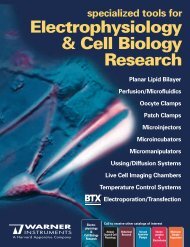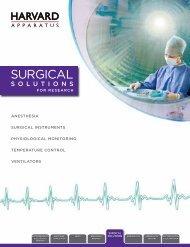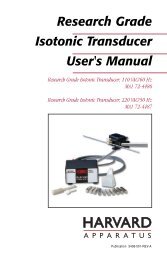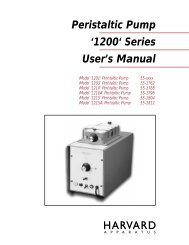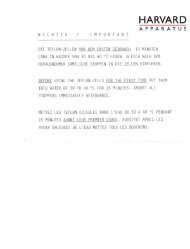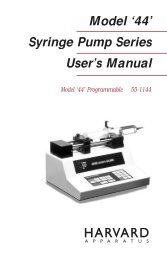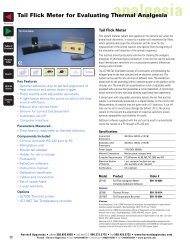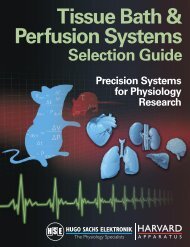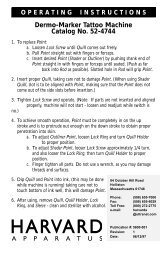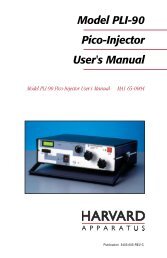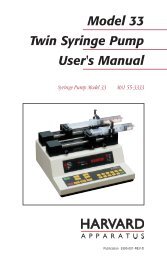View Catalog PDF - Harvard Apparatus
View Catalog PDF - Harvard Apparatus
View Catalog PDF - Harvard Apparatus
You also want an ePaper? Increase the reach of your titles
YUMPU automatically turns print PDFs into web optimized ePapers that Google loves.
Analgesia<br />
Hot-Plate for Evaluating Thermal Analgesia<br />
Hot Plate<br />
Hot Plate<br />
The LE7406 Hot-Plate performs rapid and precise screening of<br />
analgesic drug properties on small-laboratory animals according to the<br />
‘hot-plate test’. The animal’s pain sensitivity alterations induced by a<br />
specific experimental context change and/or genetic manipulations<br />
can also be evaluated through this method.<br />
The hot-plate test, initially described by N.B. Eddy and D. Leimbach<br />
(1953), evaluates thermal pain reflexes due to footpad contact with a<br />
heated surface. During the experiments, the animal is confined in a<br />
removable clear acrylic cylinder where the latency time to the first<br />
hind paw or/and jumping responses are measured.<br />
In the LE7406 Hot-Plate, a thick aluminum plate (10 mm) provides a high<br />
temperature stability and even surface distribution. The plate<br />
temperature can be held at a set point between 45 and 62°C (± 0.1°C) by<br />
multiple proportional feedback circuits that minimize overshoot. A builtin<br />
timer activated by an external foot switch allows precise<br />
measurement of reaction time (0.1 sec precision). A remote foot-switch<br />
controls the test start/stop allowing rapid hands-free experiments. The<br />
operator can read the animal reaction time from the display or from a PC<br />
computer using the SeDaCom software. Trial number, plate temperature<br />
and reaction time are then sent to the PC through a RS-232 port.<br />
Key Features<br />
➤ Digital set point<br />
➤ Built-in electronic timer<br />
➤ Foot switch timing operation<br />
➤ Computer interface<br />
Parameters Measured<br />
➤ Time latency to 'paw licking'<br />
➤ Time latency to 'jumping'<br />
Components Included<br />
➤ Base with heating plate<br />
➤ Footswitch<br />
➤ Data transfer software included (SeDaCom)<br />
➤ Cables and connectors<br />
➤ Certificate of calibration<br />
➤ Instruction manual<br />
➤ Set of spare fuses<br />
➤ 2 year warranty<br />
Options<br />
➤ LE7000 Thermal printer<br />
Specifications<br />
Base Dimensions<br />
Plate Dimensions<br />
Cylinder Dimensions<br />
Operating Temperature<br />
Reaction Time<br />
Material Composition<br />
Computer Requirements<br />
Maximum Number of<br />
Stations<br />
Power Requirements<br />
Certifications<br />
Order # Model<br />
200 (W) x 300 (D) x 110 (H) mm<br />
200 (D) mm<br />
200 (D) x 250 (H) mm<br />
45 to 62 degrees Celsius; 0.1 steps<br />
3 digits, 0.01 sec increment<br />
Clear methacrylate (animal holder), aluminum (plate)<br />
PC (Windows ® 95, 98, ME, NT, 2000 and Vista)<br />
1 per computer<br />
(multiple set-ups also available under request)<br />
110V or 220V, 50/60Hz<br />
CE compliant<br />
Product<br />
BH2 76-0113 LE 7406 Hot-Plate Thermal Analgesia Meter Including<br />
SeDaCom Software<br />
OPTIONS<br />
BH2 76-0114 LE7000 Thermal Printer<br />
Citations<br />
Puentes B et al. (2009) Sigma-1 receptors regulate activity-induced spinal sensitization and<br />
neuropathic pain after peripheral nerve injury. Pain. 145(3):294-303. (mouse, Spain)<br />
Viosca J et al. (2009) Germline expression of H-RasG12V causes neurological deficits associated to<br />
Costello syndrome. Genes, Brain Behav. 8(1):60-71. (mouse, Spain)<br />
Luvisetto S et al. (2008) Enhancement of anxiety, facilitation of avoidance behavior, and occurrence of adultonset<br />
obesity in mice lacking mitochondrial cyclophilin D. Neuroscience. 155(3):585-596 (mouse, USA)<br />
Sudo RT et al. (2008) The Antinociceptive Activity of a New alpha-2 Adrenoceptor Agonist<br />
(PT-31) in Mice. Anesthesiology 2007; 107: A1455. (Mouse, Brazil)<br />
Camarasa J et al. (2006) Association of caffeine to MDMA does not increase antinociception by<br />
potentiates adverse effects of this recreational drug. Brain Res. 1111:72-82. (mice, Spain)<br />
Grillet N et al. (2005) Generation and characterization of Rgs4 mutant mice. Mol. Cell. Biol. 25(10):<br />
4221-4228. (mice, France)<br />
38<br />
<strong>Harvard</strong> <strong>Apparatus</strong> • phone 508.893.8999 • toll free U.S. 800.272.2775 • fax 508.429.5732 • www.harvardapparatus.com<br />
Panlab | <strong>Harvard</strong> <strong>Apparatus</strong> • Spain +34934190709 • International +34834750697 • fax +34934750699 • www.panlab.com


